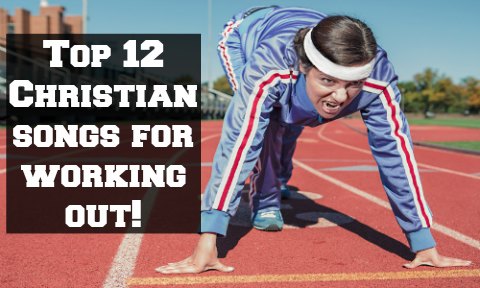Top 12
Christian Songs For
Working Out!

 I started working out again this year and no longer listen to very much secular music. So I assembled some of my favorite Christian music containing driving tempos.
I started working out again this year and no longer listen to very much secular music. So I assembled some of my favorite Christian music containing driving tempos.
Unfortunately, most contemporary Christian music rarely drives strong throughout the entire song. It took some work to find songs that rock from beginning to end, but I managed to do it — 12 songs total!
My list below also features information from University Health Network praising the benefits of working out to music with tempo-pace synchronization. These songs are in no particular order. (And some of them are a bit more on the heavy side.) Have a great workout and happy listening!
My Top 12 Favorite Christian Workout Songs…
Until The Whole World Sings – Casting Crowns * YouTube
Soul On Fire – Third Day * YouTube
Greater – Mercy Me * YouTube
Listen To The Sound – Building 429 * YouTube
Love Come To Life – Big Daddy Weave * YouTube
Born Again – Newsboys * YouTube
Afterlife – Switchfoot * YouTube
You Reign – Mercy Me * YouTube
On Our Side – Chris Tomlin * YouTube
Let Your Glory Shine – Lincoln Brewster * YouTube
Start A Fire – Unspoken * YouTube
This Is Amazing Grace – Phil Wickham * YouTube
Turn On The Lights – Sanctus Real * YouTube
Please Leave a Comment and Tell Us Your Favorite Workout Songs! (And Check Out the Short Article Below with Interesting Info about How Working Out to Music Helps Your Health!)
The use of personalized music playlists with tempo-pace synchronization increases adherence to cardiac rehab by almost 70 percent — according to a study published in Sports Medicine –Open.
“Cardiac rehab has been proven to improve long-term survival for someone who’s had a heart event by 20 percent,” said David Alter, Senior Scientist, Toronto Rehab, University Health Network and Institute for Clinical Evaluative Sciences. “Our challenge is there is a high dropout rate for these programs and suboptimal adherence to the self-management of physical activity.”
In Alter’s study, each research subject’s personalized playlist was the music genre they enjoyed with tempos that matched their predetermined walking or running pace.
“The music tempo-pace synchronization helps cue the person to take their next step or stride and helps regulate, maintain and reinforce their prescribed exercise pace,” explained Alter, who is also Research Chair in Cardiovascular Prevention and Metabolic Rehabilitation at Toronto Rehab, UHN.
Thirty-four cardiac rehabilitation patients from Toronto Rehab participated in the study: one third of the patients didn’t have any music during their cardiac rehab exercises; and the other two-thirds had audio devices with personalized music playlists during their cardiac rehab exercises. Among those who had music, half received tempo-pace synchronized audio devices, which means their music playlists were sonically modified by embedding extra rhythmic beats — called rhythmic auditory stimulation (RAS) — to further enhance tempo-pace synchronization. Patients receiving RAS were unaware that their music playlists had been modified.
The patients who used the personalized music playlists with tempo-pace synchronization did an average of 105.4 minutes more exercise than patients who did not use music. Patients who received RAS had the greatest increase in their total physical activity, achieving 261.1 minutes or more of weekly physical activity than their music or non-music playlist counterparts — corresponding to a 70 percent increase in weekly exercise.
“If this average increase of exercise was sustained for an average 65-year-old male patient, it would correlate with a projected life-expectancy increase of two and a half years,” said Alter.
Future clinical trials will be designed to further test the clinical application of tempo-pace synchronized music playlists with and without RAS in cardiac rehab patients.
Source – University Health Network


